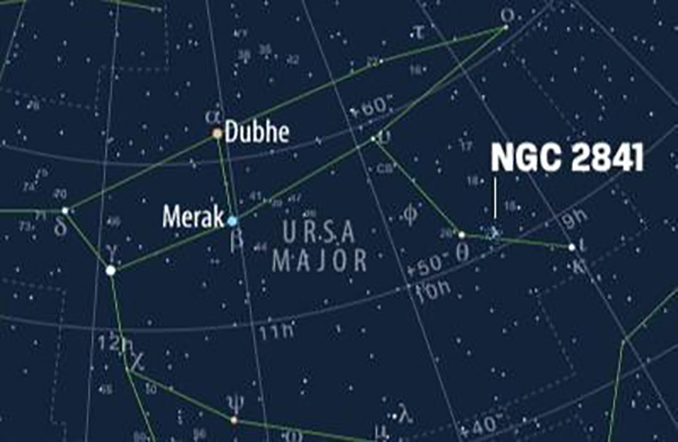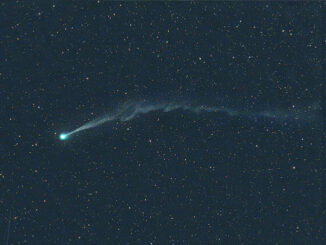
When: throughout the night during February
What’s special: NGC 2841 in Ursa Major (UMa), the Great Bear, is one of the best galaxies without a coveted Messier designation (or an entry in the Caldwell Catalogue for that matter) in the entire sky. This shouldn’t put you off slewing straight to this marvellous galaxy as soon as it’s dark.
NGC 2841 is a large and bright unbarred spiral galaxy with a noticeably inclined presentation to our line of sight that gives it an elevated surfacebrightness. This makes NGC 2841 a viable target through a pair of 10 × 50 binoculars and an easy capture for a small telescope, especially when you factor in its location high in the northern sky, which means it’s circumpolar (never setting) from UK shores and lies almost exactly at the zenith (directly overhead) when it culminates, unhindered by deleterious effects of the atmosphere.
American astronomy writer Phil Plait sums up NGC 2841 marvellously: “Toward the constellation of Ursa Major sits a rather unremarkable galaxy. It is not undergoing huge bursts of star formation. It is not blasting out radiation from its core. It isn’t twisted into bizarre shapes by the gravitational influence of a nearby passing galaxy, nor actively eating any smaller galaxies, nor swaddled in thick layers of dust. It just is, sitting there, being a spiral galaxy. And that’s what makes it so stunningly gorgeous”. Perfectly-put-together indeed.
How to observe it: NGC 2841 is easy to track down as it’s located adjacent to the narrow isosceles triangle-shape of third-magnitude stars theta (θ), kappa (κ) and iota (ι) UMa, in Ursa Major’s far south-western quadrant. It lies closest to the first, being just 1.8 degrees to its southwest. At about mid-month, the galaxy offers a very favourable observing window about 11 hours long; essentially, while it’s dark, it’s well up.
NGC 2841 has a catalogued magnitude of +9.3 and its 68-percent inclined disc spans an impressive 8.1′ × 3.8′. A small telescope in the 80–100mm (~three- to four-inch) class shows a concentrated halo of around 3′ across, orientated south-east to north-west.
Amateur astronomers have produced some fantastic shots of NGC 2841, showing its tightly wrapped multiple spiral arms (its morphological classification is SA(r)b).
Astronomers term NGC 2841 a ‘flocculent‘ galaxy, meaning that its spiral arms are clumpy, or patchy in nature, rather similar to those of Messier 63, the Sunflower Galaxy in Canes Venatici. This is seen especially along NGC 2841’s northern flank.
If you want to catch a glimpse of the spiral arms, they start to appear under fine conditions through a 150mm (six-inch) telescope as a mottled haze, when NGC 2841’s halo extends to about 5′ × 1.5′ around a 1′-sized core.
Physically, NGC 2841 is a very large galaxy that comfortably outstrips our own Milky Way Galaxy, boasting a diameter in excess of 150,000 light years. It lies 46 million light years distant.




